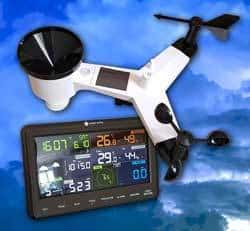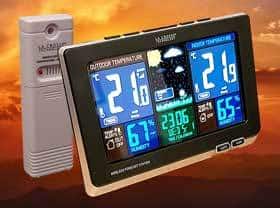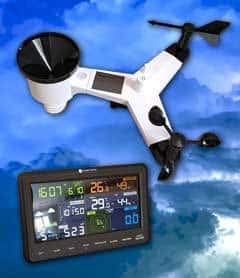The Various Advantages Of Owning A Home Weather Station

Numerous readers worldwide, including a large number of small to medium businesses, already own a home or personal weather station. This raises the question of what the real benefits of owning one are.
The primary benefits of a home weather station are its ability to provide real-time weather monitoring, accurate local forecasting, global data integration and sharing, ease of use, convenience, and remote access. Most modern intermediate-level home weather stations have these abilities.
In today's world, where instant information is available for just about everything that goes on in and around you, it is no wonder that people will want to have instant access to their weather data as well.
And this growing trend is not limited to just weather enthusiasts. Worldwide, individuals want the convenience of knowing what the weather is like inside and outside their homes to dress accordingly and make the necessary preparations.
An increasing amount of large and small companies operating outdoors are also starting to rely on the information personal weather stations provide to monitor conditions and schedule projects.
All of which may still leave you in doubt whether you will get any real benefit out of owning your own weather station. This post defines a home weather station and then looks at its various benefits and advantages.
Home Weather Station Definition
There are literally hundreds of weather stations available today. They range from a simple analog thermometer to highly integrated electronic weather stations with multiple indoor and outdoor sensors while also connected to the internet and your smart home.
Before we start to discuss it in detail and look at all the benefits, it is essential to first gain a clear understanding of precisely what a home weather station is:
What Is A Home Weather Station?

The primary benefits of a home weather station are its ability to provide real-time weather monitoring, accurate local forecasting, global data integration and sharing, ease of use, convenience, and remote access. Most modern intermediate-level home weather stations have these abilities.
The advantage of the wide range of home weather stations available is that you can locate a device that serves your specific needs.
There is a weather station out there that will suit you perfectly. No matter if you just need to know what the temperature inside your home is, or you want to measure every possible atmospheric condition in & outside the home, make forecasts and log all your weather data.
Through the years, home weather stations have advanced to the point where they can measure almost every possible weather element. The following is a list of weather elements that the advanced Ambient Weather WS-2902A Osprey weather station can measure:
- Temperature (Indoor And Outdoor)
- Relative Humidity (Indoor And Outdoor)
- Dew Point Temperature
- Barometric Pressure
- Rainfall
- Wind Speed
- Wind Direction
- Ultraviolet Radiation
- Solar Radiation
Needless to say, you don't need half these functions to enjoy all the benefits a home weather station can provide, but it does give you an indication of just how advanced modern meteorological instruments have become.
Benefits Of Owning A Home Weather Station
And this brings us to the main focus of this post. In order to illustrate the different benefits of home weather stations, we will use two examples that are used for two different purposes.
The first is the Ambient Weather WS-2902A Osprey. This is the station I use for all my "serious" weather observations and research. It is one of the most advanced home weather stations available and sits on the more expensive side of the weather station price scale.

The second is the La Crosse Technology 308-1414B. I use this affordable device in my study to get a quick indication of the basic weather conditions in and outside the home. It is very affordable for what it offers, but note that there are even more affordable devices available.
These two stations will be used to illustrate specific benefits and drawbacks throughout the following sections. The most significant benefits of home weather stations can be summarized in seven key points:
- Real-Time Weather Monitoring
- Accurate Forecasting (For Your Location)
- Global Integration And Sharing Of Data
- Ease Of Use
- Convenience And Comfort
- Remote Access
- Affordability
You will be able to get a quick understanding of what each key point entails by simply glancing at the concise explanation provided as we go through each point in more detail.
1) Real-Time Weather Monitoring
A weather forecast is exactly that; A forecast. It does not tell you the current atmospheric conditions are but predicts what the future state of the weather will be. And it definitely does not tell you what the present weather conditions are like in your specific location.
This is where the first and most obvious advantage of a home weather station comes into play. Even the most modest and affordable device will tell you what the basic atmospheric conditions are like at any given time in your immediate surroundings.
(And even if a local weather forecaster or app shows you the indicated real-time data, it is not specific to your exact location and is an educated guess at best.)
2) Accurate Forecasting (For Your Location)
National and regional forecasts do an increasingly good job of making accurate weather predictions.
However, as you may have already experienced yourself, there is a big difference between local and regional weather. It simply means that there are pockets of smaller weather patterns within a larger regional weather system.
For example, your home or neighborhood may experience a very different kind of weather than the rest of your city or state is experiencing.
(If you are interested, you can read more about the difference between local and regional weather in this article.)

Here, the forecasting capabilities of a good home weather station come in very handy. For example, the Ambient WS-2902A station, with its large number of internal and external sensors, does a great job of predicting the weather in your area for the upcoming hours.
Even the budget-orientated La Crosse 308-1414B, with its limited amount of sensors, is doing a surprisingly good job at predicting short-term weather, especially if you consider that its indoor and outdoor sensors only measure temperature and humidity.
As I mentioned numerous times in other posts on this website, there are three weather elements that are vital for making an accurate weather forecast:
- Temperature
- Humidity
- Barometric Pressure
Through research and personal experience, I discovered that the measurement of these three components is the minimum requirement for a precise weather forecast. This is what makes the accuracy of the Lacrosse station so impressive, lacking barometric sensors.
In conclusion, a home weather station is much better at making a short-term (up to 12 hours) weather prediction of weather conditions in your specific location than a regional or broad local forecasting service can provide.
3) Global Integration And Sharing Of Data
More home weather station owners are connecting their weather stations to the Internet than ever before. This is due to the built-in function of more advanced stations to quickly connect to a local internet connection, like a wireless router.
This function has two significant advantages, namely remote access to your weather station readings and the ability to integrate your device into a global network and share your data. The latter benefit also allows you to contribute to global forecasting networks.
1) Remote Access To Your Weather Station
Remote access is a powerful feature. The Ambient WS-2902A weather station, for example, is connected via WiFi to my Internet router. This function allows me to connect to Ambient Weather's own network, called Ambientweather.net.
I can access this site from anywhere in the world from any device with an internet connection. It not only shows you all the atmospheric conditions the weather station is currently measuring, but also keeps a log of all the weather the device has ever recorded.
(This allows one to track and compare weather conditions over months and years, which enables you to establish weather trends, making local forecasting even more accurate.)
2) integrating Your Device Into A Global Network And Sharing Weather Data
This function is a perfect example of how valuable & effective the cooperation of thousands of weather station owners is in contributing to a very accurate global forecasting system.

Many home weather stations, like the Ambient WS-2902A, can be registered on a global forecasting network like Weather Underground (Wunderground) and weathercloud.net.
At the time of writing, Weather Underground already had more than 250 000 weather stations connected to their network. They use all the data from each station to assist in creating surprisingly accurate predictions, especially local weather forecasts.
As a true weather enthusiast, there are few things as satisfying as knowing that your own weather station is part of a global network that collaborates to create one of the best forecasting systems available today.
4) Ease Of Use
Modern weather stations are extremely easy to install and operate. Most come with extensive written or online instructions that are easy to follow. If that is not sufficient, the chances are very good that you will be able to find a YouTube tutorial posted by a user.
Some weather stations with more extensive external weather sensor arrays will require more time and effort to assemble. It may seem intimidating at first, but by following the instruction, it is a relatively painless task.
The Ambient WS-2902A is an example of such a setup. The La Crosse 308-1414B, on the other hand, has a single compact outdoor sensor unit that one can simply stick or screw into a wall. Either way, it is a fairly straightforward process.
The indoor display units are a breeze to set up. Instructions are provided, but in most cases, the onscreen setup wizard quickly takes you through the installation process. This is the case with both weather stations, which are used as examples in this post.
Viewing and changing elements on the displayed units are also simple, as each symbol and value is clearly marked and logically laid out. Even if the sheer number of information on the screen may seem overwhelming, you will get used to it in no time at all.
5) Convenience And Comfort
The convenience of owning a home weather station should be evident by now. Without leaving the comfort of your home (and sometimes even your bed), you can quickly gauge the weather conditions outside, as well as the indoor temperature and humidity.
The ability to know what the conditions outside your home are like without having to brave potentially scorching hot weather or freezing cold first provides a substantial level of comfort and convenience.
This benefit not only allows you to dress accordingly and make any other necessary preparations, but weather stations with forecasting abilities also allow you to better plan your day.
6) Remote Access
We already touched on this subject when discussing Global Integration And Sharing Of Data. Most modern advanced home weather stations, regardless of make, have their online network on which you can register your device.

This function allows you to see whatever the atmospheric conditions are like at your home from any location in the world where you have access to the Internet. It is available on your laptop, PC, phone, or tablet.
I already pointed out how Ambient Weather allows the WS-2902A to connect to its online network. It is by no means the only manufacturer that provides its own online network.
Any device that a user connects to Wunderground can also be accessed worldwide, and you can read all your current weather readings in detail directly from their page.
One more advantage of remote access is the ability to control your smart home and adjust to changing weather conditions. It may be a relatively recent development, but by having your devices connected to a smart home network, you make any adjustments from anywhere.
The Ambient WS-2902A already has IFTTT functionality, meaning it can integrate with your smart home system. It allows you to set up devices in your home to respond if certain weather conditions are met (like closing the blinds, switching on the aircon, etc.)
7) Affordability
Weather stations don't just come in all shapes and sizes but also vary from extremely affordable to relatively expensive, depending on your specific requirements.
It is clearly evident from simply looking at the price difference between the two weather stations used as examples throughout this post.
The more budget-orientated La Crosse Technology 308-1414B device is available for around 50 Us dollars. On the opposite side of the spectrum, the advanced Ambient Weather WS-2902A Osprey will set you back approximately 150 US dollars.
There are even cheaper as well as more expensive home weather stations on the market. Depending on what you are looking for in a meteorological device, you can find a basic system for as little as 8 dollars to a comprehensive high-end station for 1 000 dollars.
The two devices used in this post are by no means the best available by any means. They are just two examples of weather stations that do what they are supposed to do very well. There is a multitude of instruments out there that are as good or maybe even better.
This means that whatever your needs, there will be a home weather station you can afford and that meets most, if not all, of your requirements.
Conclusion
After reading through all the benefits laid out in this post, you should be able to decide for yourself if you need or can really benefit from owning a home weather station. As the post clearly showed, there are numerous advantages to a variety of different requirements.
If you are still unsure, the following guidelines may help. If you feel you need or can benefit from three or more of the advantages listed in this article, you should seriously consider the possibility of owning your own weather station.
You can start with a very affordable system that won't even put a dent in your pocket. See how well it works for you, and take it from there.
As I already pointed out, the two systems used as examples in this article are by no means the best or only quality weather devices available. In the Recommended Resources section, I have already examined other weather stations that are worth looking at more closely.
In the future, I will share my findings in a comprehensive post whenever I obtain and start using a new weather station.
The aim of this article was to highlight the most important benefits and clear up any confusion when it comes to these weather devices. I trust it helped you in deciding if you've been sitting on the fence or wondering if you really need a home weather station.
Never miss out again when another interesting and helpful article is released and stay updated, while also receiving helpful tips & information by simply clicking on this link .
Until next time, keep your eye on the weather!
